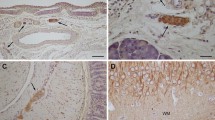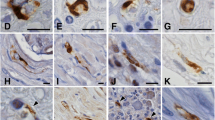Abstract
The immunohistochemical localization of cathepsin D (CD) was demonstrated for the first time in 54 schwannomas (32 intra- and 22 extracranial; 47 benign and 7 malignant) and 5 normal nerve fibers. Granular or vesicular CD-reactive structures were observed in all normal Schwann cells. All tumors contained CD-reactive tumor cells, although the population of CD-reactive tumor cells, the density, intracellular localization, and morphology of CD-reactive structures, and the intensity of CD immunore-activity varied from case to case, portion to portion, and cell to cell, differing variously from those in normal Schwann cells. The variations were greater in malignant than in benign schwannomas. In mildly degenerate tumor cells, CD immunoreactivity was increased, possibly in response to the increased intracellular degenerate proteins, suggesting that the mechanism of induction of lysosomal proteases preserved in normal cells is not affected by the process of neoplastic transformation. In lesions of severe degeneration or necrosis, CD immunoreactivity was lost in most tumor cells but was strong in macrophages invading the lesions and perivascular regions. CD immunoreactivity was observed at various intensities in tumor cells in the Antoni type A area but not in most tumor cells in the Antoni type B area, suggesting that Antoni type B lesions show degenerative changes. The presence of CD-reactive tumor cells in all tumors examined and strong CD immunoreactivity observed at the invasion front of tumors in some cases of benign or malignant schwannoma suggests the possible role of CD in tumor invasion in some cases.
Similar content being viewed by others
References
Kirschke H, Barrett AJ (1987) Chemistry of lysosomal proteases. In: Glauman, H, Ballard FJ (eds) Lysosomes: their role in protein breakdown, Academic London, pp 193–237
Conner GE, Blobel G., Erickson AH (1987) Biogenesis of lysosomal proteinases: polypeptide chain. In: Glauman H, Ballard FJ (eds) Lysosomes: their role in protein breakdown. Academic, London, pp 151–161
Sivapalvathi m, Sawaya R, Chintala SK et al. (1996) Expression of cathepsin D during the progression of human gliomas. Neurosci Lett 208:171–174
Warich M, von Bossanyi P, Dietmann K (1995) Expression of cathepsin D in human astrocytic neoplasias. Gen Diagn Pathol 141:93–96
Robson DK, Ironside JW, Reid WA et al. (1990) Immunolocalization of cathepsin D in the human central nervous system and central nervous system neoplasms. Neuropathol Appl Neurobiol 16:39–44
Gottschalk J, Goebel S, Jautzke G et al. (1992) Influence of preoperative dexamethasone therapy on proliferating cell nuclear antigen (PCNA) expression in comparison to other parameters in meningiomas. Histol Histopathol 7:653–661
Gohring UJ, Scharl A, Thelen U et al. (1996) Comparative prognostic value of cathepsin D and urokinase plasminogen activator, detected by immunohistochemistry, in primary breast carcinoma. Anticancer Res 16:1011–1018
Leto G, Gebbia N, Rausa L et al. (1992) Cathepsin D in the malignant progression of neoplastic diseases (review). Anticancer Res 12:235–240
Wistanley JH, Leinstar SJ, Cooke TG et al. (1993) Prognostic significance of cathepsin D in patients with breast cancer. Br J Cancer 67:767–772
Saku T, Sakai H, Tsuda N et al. (1990) Cathepsins D and E in normal, metaplastic, dysplastic, and carcinomatous gastric tissue: an immunohistochemical study. Gut 31:1250–1255
Valentin AM, Pirreli M, Armentano R et al. (1996) The immuno-histochemical expression of cathepsin D in colorectal cancer. Anticancer Res 16:77–80
Holm R, Tanum G (1996) Evaluation of the prognostic significance of nm23/NDP kinase and cathepsin D in anal carcinomas. An immunohistochemical study. Virchows Arch 428:85–89
Resnick JM, Uhrman D, Niehans GA et al. (1995) Cervical lymph node status and survival in laryngeal carcinoma. Ann Otol Rhinol Laryngol 104:685–694
Dickson AJ, Fox SB, Newcomb PV et al. (1995) An immunohistochemical and prognostic evaluation of cathepsin D expression in 105 bladder carcinomas. J Urol 154:237
Moul JW, Maygarden SJ, Ware JL et al. (1996) Cathepsin D and epidermal growth factor receptor immunohistochemistry does not predict recurrence of prostate cancer in patients undergoing radical prostatectomy. J Urol 155:982–985
Henzen-Logmans SC, Fieret EJ, Berns EM et al. (1994) Ki-67 staining in benign, borderline, malignant primary and metastatic ovarian tumors: correlation with steroid receptors, epidermal growth factor receptor and cathepsin D. Int J Cancer 57:468–472
Nielsen AL, Nyholm HC (1995) Endometrial adenocarcinoma of endometrioid subtype with squamous differentiation: an immunohistochemical study of MIB-1 (Ki-67 paraffin), cathepsin D, and c-erbB-2 protein (p185). Int J Gynecol Pathol 14:230–234
Kristensen GB, Holm R, Abeler VM et al. (1996) Evaluation of the prognostic significance of cathepsin D, epidermal growth factor receptor and c-erbB-2 in early cervical squamous carcinoma. An immunohistochemical study. Cancer 78:433–440
Holm R, Hoie J, Kaalhus O et al. (1995) Immunohistochemical detection of nm23/NDP kinase and cathepsin D in medullary carcinomas of the thyroid gland. Virchows Arch 427:289–294
Vigniswaran N, Muller S, DeRose P et al. (1994) Cathepsin D and tumor associated antigen DF3 in salivary gland neoplasia. Differential diagnostic and prognostic applications. Pathol Res Pract 190:1174–1184
Kageshita T, Yoshii A, Kimura T et al. (1955) Biochemical and immunohistochemical analysis of cathepsin B, H, L and D in human melanocytic tumors. Arch Dermatol Res 287:266–272
Maygarden SJ, Novotony DB, Moul JW et al. (1994) Evaluation of cathepsin D and epidermal growth factor receptor in prostate carcinoma. Mod Pathol 7:930–936
Burger PC, Scheithauer BW, Vogel FS (1991) Intracranial Schwann cell neoplasms. In: Burger PC, Scheithauer BW, Vogel FS (eds) Surgical pathology of the nervous system and its coverings. 3rd ed. Churchill Livingstone, New York, pp 398–405
Enzinger FM, Weiss SW (1995) Malignant tumors of the peripheral nerves In: Enzinger FM, Weiss SW (eds) Soft tissue tumors. 3rd ed. Mosby, St. Louis, pp 889–928
Sloane BF, Lah TT, Day NA et al. (1986) Tumor cysteine proteinases and their inhibitors. In: Turk V (ed) Cysteine proteinases and their inhibitors Proc Int Symp Portoroz 1985 de Gruyter, Berlin, pp 729–749
Menrad A, Speicher D, Wacker J et al. (1993) Biochemical and functional characterization of aminopeptidase N expressed by human melanoma cells. Cancer Res 53:1450–1455
Ii K, Hizawa K, Kominami E et al. (1985) Different immunolocalizations of cathepsins B, H and L in the liver. J Histochem Cytochem 33:1173–1175
Ii K, Hizawa K, Nonaka I et al. (1986) Abnormal increases of lysosomal cysteine proteinases in rimmed vacuoles in the skeletal muscle. Am J Pathol 122:193–198
Ii K, Ito H, Kominami E et al. (1993) Abnormal distribution of cathepsin proteinases and endogenous inhibitors (cystatins) in the hippocampus of patients with Alzheimer's disease, parkinsonism-dementia complex on Guam, and senile dementia and in the aged. Virchows Arch A 423:185–194
Enzinger M, Weiss SW (1995) Neurilemmoma (benign schwannoma). In: Enzinger FM, Weiss SW (1995) Soft tissue tumors. Mosby, St. Louis, pp 829–838
Liotta LA (1986) Tumor invasion and metastases—role of extracellular matrix: Rhodes Memorial Award Lecture. Cancer Res 46:1–7
Monteagudo C, Merino MJ, San-Juan J et al. (1990) Immunohistochemical distribution of type IV collagenase in normal, benign and malignant breast tissues. Am J Pathol 136:585–592
Lacout A, Obled A, Christiane D et al. (1986) Postmortem localization of lysosomal peptide hydrolase, cathepsin B. In: Turk V (ed) Cysteine proteinases and their inhibitors. Proc Int Symp Portoroz 1985, de Gruyter, Berlin, pp 239–248
Etherington DJ, Maciewicz RA, Taylor MAJ et al. (1986) The role of collagen-degrading cysteine proteinases in connective tissue metabolism. In: Turk V (ed) (1986) Cysteine proteinases and their inhibitors. Proc Int Symp Portoroz 1985. de Gruyter, Berlin, pp 269–282
Machleidt W, Ritonja A, Povoic T et al. (1986) Human cathepsins B, H and L: Characterization by amino acid sequences and some kinetics of inhibition by the kininogens. In: Turk V (ed) Cysteine proteinases and their inhibitors. Proc Int Symp Portoroz 1985. de Gruyter, Berlin, pp 3–18
Sloane BF, Rozhin J, Moin K et al. (1989) Cathepsin B and endogenous cystein proteinase inhibitors in metastatic tumors. In: Katunuma N, Kominami E (eds) Intracellular proteolysis. Mechanisms and regulations. Proc 7th ICOP Meeting, Shimoda, pp 527–533
Poole AR, Hembly RM, Dingle JT (1974) Cathepsin D in cartilage: the immunohistochemical demonstration of extracellular enzyme in normal and pathological condition. J Cell Sci 14:139–161
Cravioto H (1969) The ultrastructure of acoustic nerve tumors. Acta Neuropathol (Berl) 12:116–140
Nagai T, Todo S, Imashuku S (1986) Distinct isozyme patterns of cyclic nucleotide phosphodiesterase in human neuroblastoma and ganglioneuroma; a possible marker of differentiation of neural crest-derived tumors and Schwannoma cells. Jpn C Cancer Res 77:52–58
Rao JS, Baker JB, Morantz RA et al. (1990) Serpin inhibitors of urokinase and thrombin in normal rat brain and the 9L brain tumor: evidence for elevated expression of protease nexin I-like inhibitor and a novel sodium dodecyl sulfate-activated tumor antithrombin. Cancer Res 50:5039–5044
Muir D, Manthorpe M (1992) Stromelysin generates a fibronectin fragment that inhibits Schwann cell proliferation. J Cell Biol 116:177–185
Yasumitsu H, Miyazaki Y, Umenishi F et al. (1992) Comparison of extracellular matrix-degrading activities between 64-kDa and 90-kDa gelatinases purified in inhibitor free forms from human Schwannoma cells. J Biochem (Tokyo) 111:74–80
Rao JS, Steck PA, Mohanam S et al. (1993) Elevated levels of M(r) 92,000 type IV collagenase in human brain tumors. Cancer Res 53:2208–2211
Rao JS, Rayford A, Montaz RA et al. (1993) Increased levels of plasminogen activator inhibitor-1 (PAI-I) in human brain tumors. J Neurooncol 17:215–221
Bogaert ER, Cham SK, Zimmer C et al. (1994) Inhibition of collagenolytic activity relates to quantitative reduction of invasion in vitro in a c-Ha-ras transfected glial cell line. J Neurooncol 21:141–150
Muller M, Hubbard SL, Fukuyama K et al. (1995) Characterization of a pineal region malignant rhabdoid tumor. Towards understanding brain tumor cell invasion. Pediatr Neurosurg 22:204–209
Matsuzawa K, Fukuyama K, Hubbard SL et al. (1996) Transfection of an invasive human astrocytoma cell line with a TIMP-1 cDNA: modulation of astrocytoma invasive potential. J Neuropathol Exp Neurol 55:88–96
Yoshida E, Maruyama M, Sigiki M et al. (1994) Immunohistochemical demonstration of bikunin, a light chain of inter-alpha-trypsin inhibitor, in human brain tumors. Inflammation 18:589–596
Rempel SA, Rosenmlum ML, Mikkelsen T et al. (1994) Cathepsin B expression and localization in glioma progression and invasion. Cancer Res 54:6027–6031
Author information
Authors and Affiliations
Rights and permissions
About this article
Cite this article
Ii, K., Peng, Y., Hirose, T. et al. Immunohistochemical localization of lysosomal cathepsin D in schwannomas. Brain Tumor Pathol 14, 87–95 (1997). https://doi.org/10.1007/BF02478876
Received:
Accepted:
Issue Date:
DOI: https://doi.org/10.1007/BF02478876




